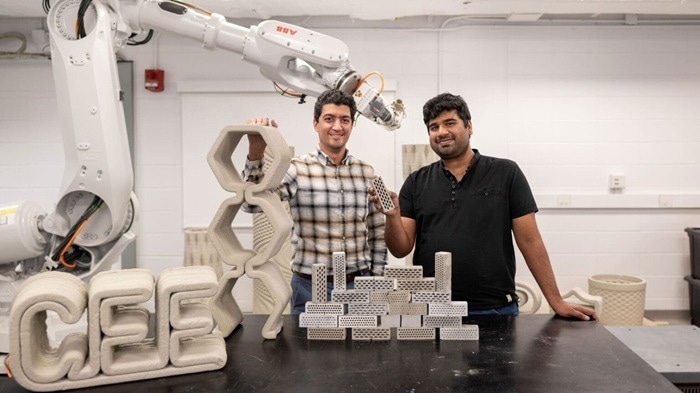Reviewed by Lexie CornerSep 17 2024
Princeton University engineers have created a cement-based material that is 5.6 times more damage-resistant than standard counterparts. Inspired by the architecture of the tough outer layer of human bone, this material avoids the cracking and sudden failure typically seen in traditional brittle cement. The research was published in Advanced Materials.
 Researchers Reza Moini and Shashank Gupta create stronger and more durable building materials. Image Credit: Sameer A. Khan/Fotobuddy
Researchers Reza Moini and Shashank Gupta create stronger and more durable building materials. Image Credit: Sameer A. Khan/Fotobuddy
The research team, consisting of third-year Ph.D. candidate Shashank Gupta and Assistant Professor Reza Moini from the Department of Civil and Environmental Engineering at Princeton University, demonstrated that cement paste with a tube-like architecture significantly increases resistance to crack propagation and enhances the material's ability to deform without sudden failure.
One of the challenges in engineering brittle construction materials is that they fail in an abrupt, catastrophic fashion.
Shashank Gupta, Ph.D. Candidate, Department of Civil and Environmental Engineering, Princeton University
In brittle construction materials used in buildings and infrastructure, strength ensures load-bearing capacity, while toughness supports resistance to cracking and damage spread. The team's approach addresses these challenges, producing a material both stronger and tougher than conventional cement.
Moini explained that the improvement stems from the material's internal architecture, which balances the stresses at the crack front with the material's overall mechanical response.
We use theoretical principles of fracture mechanics and statistical mechanics to improve materials’ fundamental properties ‘by design.’
Shashank Gupta, Ph.D. Candidate, Department of Civil and Environmental Engineering, Princeton University
The design was inspired by human cortical bone, the strong, fracture-resistant outer layer of the femur. Cortical bone consists of elliptical tubular components, or osteons, embedded in a weak organic matrix that deflects cracks and enhances fracture resistance. This concept was applied to the cement paste, where elliptical and cylindrical tubes interact with cracks to prevent sudden failure and increase resistance to crack propagation.
One expects the material to become less resistant to cracking when hollow tubes are incorporated. We learned that by taking advantage of the tube geometry, size, shape, and orientation, we can promote crack-tube interaction to enhance one property without sacrificing another.
Reza Moini, Assistant Professor, Department of Civil and Environmental Engineering, Princeton University
The researchers discovered that the interaction between cracks and tubes initiates a stepwise toughening mechanism, resulting in more energy dissipation at each interaction. The crack is first trapped by the tube, and then its propagation is delayed.
“What makes this stepwise mechanism unique is that each crack extension is controlled, preventing sudden, catastrophic failure. Instead of breaking all at once, the material withstands progressive damage, making it much tougher,” said Gupta
Unlike conventional methods that reinforce cement materials with fibers or plastics, the Princeton team's approach focuses on geometric design. By altering the material's structure, the fibers increase toughness without adding extra material.
Beyond improving fracture toughness, the researchers introduced a novel method to measure the degree of disorder, an essential design parameter. By applying principles from statistical mechanics, they developed a numerical framework to represent the architecture's degree of disorder.
This framework offers a spectrum between ordered and random arrangements, moving beyond simple binary classifications of periodic versus non-periodic structures. Moini noted that this framework distinguishes between methods like Voronoi tessellation and perturbation techniques, which conflate irregularity with statistical disorder.
“This approach gives us a powerful tool to describe and design materials with a tailored degree of disorder. Using advanced fabrication methods such as additive manufacturing can further promote the design of more disordered and mechanically favorable structures and allow for scaling up of these tubular designs for civil infrastructure components with concrete,” said Moini.
The team has also developed high-precision methods using additive manufacturing and robotics. They plan to expand the application of these materials by incorporating novel architectures and combinations of hard and soft materials within the tubes.
Gupta concluded, “We’ve only begun to explore the possibilities. There are many variables to investigate, such as applying the degree of disorder to the size, shape, and orientation of the tubes in the material. These principles could be applied to other brittle materials to engineer more damage-resistant structures.”
The CMMI Division Grant and the National Science Foundation CAREER Award funded this study.
Journal Reference:
Gupta, S. & Moini, R. (2024) Tough Cortical Bone-Inspired Tubular Architected Cement-Based Material with Disorder. Advanced Materials. doi.org/10.1002/adma.202313904